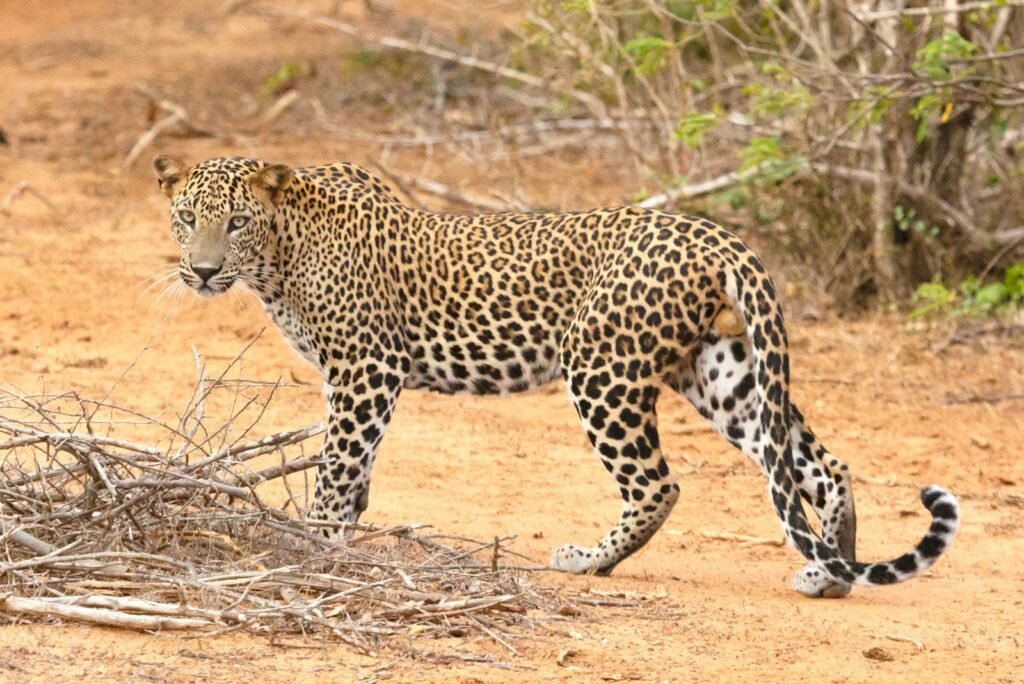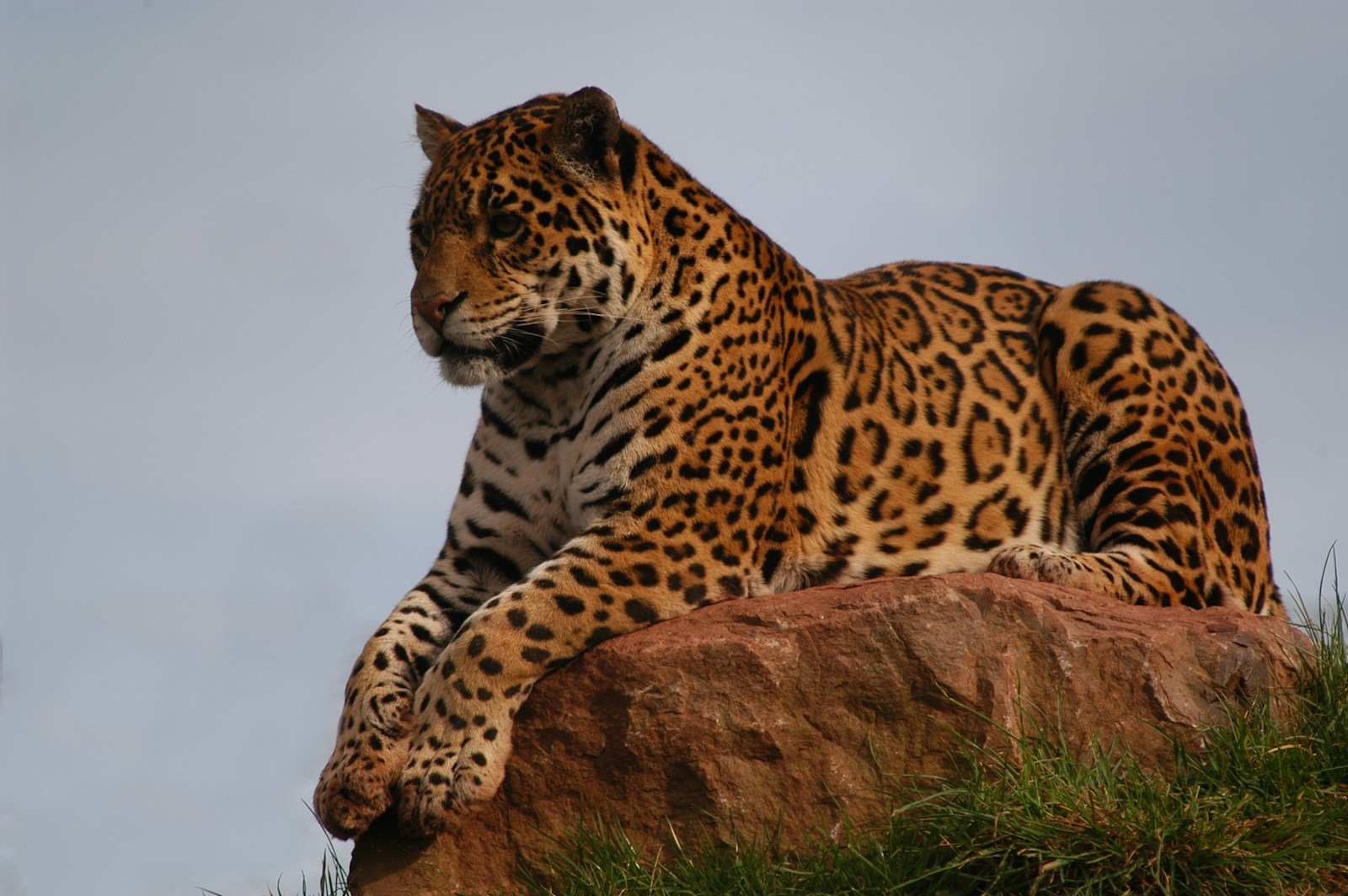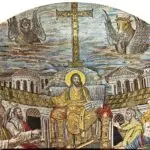“The swift leopard charges towards its prey, embodying the essence of power, agility, and ferocity.”
Leopards play an important role in biblical symbolism. They show up a lot in the Bible. Representing critical traits, they teach us much about the human spirit and spiritual world.
What does leopard symbolize in the Bible? In the Book of Daniel, a leopard is linked to a lion, bear, and a beast. They stand for different world empires’ traits. The leopard with four wings matches Alexander the Great. He rapidly spread Greek culture after conquering Persia in twelve years.
When Alexander died, his empire was split into four. This matches the four heads of the leopard. These parts were ruled by Ptolemy, Seleucus, Lysimachus, and Cassander. Just like the leopard’s agility, they acted quickly to take control of their territories.
Animals like leopards, bears, lions, and dragons are common in the Bible. They symbolize evil and violence. In Revelation, the leopard links to a malevolent “beast.” This beast aims to dominate and spread fear.
Leopards show up in many verses, like Song of Solomon and Isaiah. They are known for their speed and changing habits. Jeremiah uses leopard spots to talk about how hard it is to change fixed behaviors.
Leopards once lived in large parts of Africa and Asia. They weren’t found in Siberia or Central Asia. Varieties were local but all were known as Felis pardus. In Palestine, leopards were lighter in color and smaller. Some places in Moab’s names are possibly related to leopards.
Leopards are known for their speed and love for animals like goats. These traits are seen in the Bible. They symbolize the power of nature and spiritual truths that go beyond our physical world.
Next, we’ll dig deeper into what the leopard symbolizes. We’ll explore its meaning across various biblical stories. Join us in uncovering the deep wisdom of the leopard’s role in the Bible.
The Leopard in Daniel’s Vision
In the Book of Daniel, there’s a vision. It talks about a leopard that stands for a powerful empire. There’s also a lion, a bear, and a scary beast with iron teeth. These animals show what four kingdoms will be like in the future.
The leopard proves that the fourth beast is real. This matches with the iron legs in a previous vision (Daniel 7:1-7; 7:6).
Daniel’s vision shows four great beasts. There’s a lion with wings, a bear with ribs, a leopard with wings and heads, and a beast with iron teeth. These symbolize different world powers (Daniel 7:3-7).
The winged leopard stands for the Greek empire. It shows how Alexander the Great quickly defeated the Persians. After that, he split the land among four leaders, just as the vision said would happen (Daniel 7:6).
It’s not just the leopard that’s important in the vision. The lion is for King Nebuchadnezzar and the Babylonians. The bear is for the Medo-Persian empire after it conquered Babylon. This shows the vision points out these empires too (Daniel 7:4-5, 7).
The leopard in Daniel’s vision is a big deal. It’s about the Greek empire and how Alexander the Great changed history. The vision talks about his fast wins and how he split his empire after that.
The Leopard and Alexander the Great
In Daniel’s vision, the leopard plays a key role. It stands for Alexander the Great and his fast military wins. This can be seen in Daniel 7:6, where the leopard’s speed shows how quickly Alexander overtook the Persian Empire. He also spread Greek culture and language far.
Storytelling about Alexander often includes the image of a leopard with four wings. These wings symbolize his amazing speed and the swift victories he achieved. In only 12 years, from 334 to 323 BC, Alexander became one of the greatest conquerors. He beat the massive Persian Empire, adding new lands to his kingdom.
After Alexander died suddenly, his empire got split into four parts, just as Daniel’s vision had predicted. Each of these areas was led by one of Alexander’s trusted generals. This split had a big influence on how the map of the world looked. Egypt and its neighbors, Syria with parts of Asia Minor, Thrace, and Macedonia with Greece became their own powerful regions.
The leopard’s role in Alexander the Great’s story connects with Daniel’s vision’s main idea. It shows how different countries were at the time of Christ’s Second Coming. The quickness and power of Alexander’s takeovers highlight Greece’s important rule during that time.
This use of animal symbols also fits with a Bible idea. It’s about using big, powerful creatures to show empires or nations. For example, a lion with eagle wings stands for Babylon. The bear suggests the Medo-Persian Empire. The fourth beast is about the Roman Empire. The speedy leopard with four wings predicts the greatness of the Greek Empire under Alexander.
So, the leopard symbol helps Daniel’s vision make sense. It adds to the historical background and points out the special features of the empires it talks about.

The Leopard in the Book of Revelation
In the book of Revelation, the leopard symbolizes evil alongside the beast. It warns of danger, much like the bear, lion, and dragon. They are known for their violence and bad intentions. A Bible passage, Revelation 14:9-11, illustrates this menacing figure:
“Then a third angel followed them, saying with a loud voice, ‘If anyone worships the beast and his image, and receives his mark on his forehead or on his hand, he himself shall also drink of the wine of the wrath of God, which is poured out full strength into the cup of His indignation. He shall be tormented with fire and brimstone in the presence of the holy angels and in the presence of the Lamb. And the smoke of their torment ascends forever and ever; and they have no rest day or night, who worship the beast and his image, and whoever receives the mark of his name.’”
The term “beast” in Revelation doesn’t mean a real animal. It talks about a system or philosophy of control that uses fear to keep power. This system doesn’t care about people and acts badly.
The leopard’s role shows how mean and strong the beast system is. Its features—speed and hunting—are like a warning of the system’s harm to people. The text uses these traits as a warning about the beast’s evil impact.
Characteristics of Leopards in the Bible
The Bible talks about leopards and their characteristics. It says they are clever hunters, known for how they wait to catch their prey. They are also very fast and move with quickness and grace.
Leopards like hunting at night, which shows they are nocturnal. They can sneak up without anyone noticing because they blend into their surroundings. This makes them amazing at catching their prey.
“Their horses also (of the Chaldeans) are swifter than leopards.” – Habakkuk 1:8
In the Bible, leopards are talked about as a big danger. They threaten both people and other animals. Also, they often eat farm animals like goats, showing off their hunting ability.
In Jeremiah 13:23, the Bible uses the leopard’s spots to teach a lesson. The lesson is that some things can’t change, no matter how hard we try:
“Can the Ethiopian change his skin, or the leopard his spots?”
This teaches us that some things are just part of who we are. We can learn from this lesson.
So, in the Bible, leopards are mighty and fast hunters. They teach about the wonders of nature and the dangers in it.
The Leopard’s Symbolic Meaning
In the Bible, leopards symbolize fierce strength and sharpness. They are linked to traits like being fierce, quick, and agile. This makes them powerful figures in the Bible’s stories.
A good example is in the tale of Alexander the Great. He overcame the Persian Empire rapidly, mirroring the leopard’s speed in action. This story highlights how the leopard’s traits link to victories in history.
In the book of Revelation, the leopard symbolizes a mean force. It represents a government or idea that spreads fear and chaos. Here, the leopard shows its dangerous side.
“The leopard in the Bible stands for swiftness and strength. Its role, from Alexander’s days to Revelation, shows its symbolic power.”
The leopard’s natural habitat is in Africa and Southern Asia. This shows its ability to live in many places, proving its adaptability. Leopards truly are nature’s versatile hunters.
In the Bible, “leopard” often symbolizes a strong and fierce creature. It’s mentioned with other mighty animals like lions, bears, wolves, and horses. This reinforces the leopard’s image as a symbol of power.
Bible verses like Habakkuk 1:8 point to leopards’ speed. And Jeremiah 13:23 speaks of their unique spots. These references show the leopard as a symbol of quickness and uniqueness.
To sum up, leopards in the Bible represent strength, quickness, and sharp thinking. They stand for ancient empires’ power, evil governments, and natural adaptability. Leopards play key roles in the Bible’s symbolic stories.
The Leopard and Change in Jeremiah
In the book of Jeremiah, the leopard shows a key idea: some things can’t change. The verse Jeremiah 13:23 asks, “Can the Ethiopian change his skin or the leopard his spots? Neither can you do good who are accustomed to doing evil.”1
This points to the unchanging nature of both leopards’ spots and people’s bad habits. It means once people start doing bad things, it’s hard for them to do good again. Like how leopards will always have their spots, people stuck in sin struggle to change. The message is clear: without help, changing your ways is tough.
Jeremiah uses the leopard as a warning about change. It reminds us not to ignore the need for turning away from wrong and towards good. We are prompted to recognize our wrongs and ask for help from above. This can truly transform hearts and lives.
Reference:
1. Jeremiah 13:23, Holy Bible, New International Version.
Distribution of Leopards in Biblical Times
Leopards are known for their spots and wild spirit. They were in many places during biblical times. These included regions like Palestine, Arabia, Lebanon, Syria, Africa, and Asia. In Palestine, they were lighter and smaller than African and Indian leopards.
Yet, leopards started disappearing in some areas. Places like the valleys east and south of the Dead Sea, and in Sinai and Northwestern Arabia. This happened because of lost homes and actions of people.
Today, the Arabian leopard is endangered. It’s found in small numbers in the Negev Desert of Israel and the Arab Peninsula. Still, we need more research to know all about leopards in different places. This includes learning about their speed and agility in Palestine.
The Bible talks about leopards in a few places. They’re often mentioned with lions, bears, and wolves. Leopards symbolize fierceness, power, and quickness. This is clear in verses like Daniel 7:6, Hosea 13:7, and Revelation 13:2.
Exploring the meaning and mentions of leopards in the Bible can help us understand more. We can learn about their importance in culture and spirituality.
Fashion and Hunting of Leopards
Leopards have long been hunted for their stunning skins, a hot item in fashion. Regrettably, this led to the poaching of many leopards. This severe hunting had terrible effects on their numbers and survival.
In 1963, a report showed that 50,000 leopards were killed for fashion in one year. Each coat needed 5 to 7 leopard skins. These skins came from places like Somalia and Ethiopia, making things worse for leopards.
“Leopard skins were highly sought after in the fashion industry, leading to the poaching of thousands of these magnificent animals.”
The danger of leopards being hunted for fashion sparked a conservation push. Many efforts have emerged to stop poaching and save their homes. This has led to improvements in protecting these amazing big cats.
Also, the fashion world is changing for the better. More designers are choosing not to use real fur. They are picking ethical and planet-friendly materials. This includes faux fur that looks and feels like the real thing but it’s better for the animals.
Thanks to these changes, there’s more hope for leopards. But it’s still very important to spread the word about why they need protecting. This is not just about saving the leopards. It’s about keeping our planet’s ecosystems healthy and balanced for all species.
Leopards in Comparison to Other Animals
Leopards stand out as captivating animals. They are often mixed up with cheetahs, lions, and panthers. We’ll look into what makes leopards special and different from these animals.
Leopards and cheetahs both have spots on their fur. But, they are different. Leopards are very adaptable and quick. Cheetahs, on the other hand, are known for their speed, the fastest on land.
“Leopards and cheetahs may share spots, but their unique qualities set them apart. The leopard’s versatility and the cheetah’s unmatched speed highlight their individual strengths.”
Yet, compared to lions, leopards are smaller. But, this does not make them any less impressive. Leopards are agile, smart, and very strong for their size. They are also great climbers, even with their prey.
“While lions may be larger and more powerful, leopards possess a nimbleness that allows them to navigate their environment with finesse.”
Now, let’s clear up the leopard and panther mix-up. It is due to naming and region-based differences. A black leopard is called a panther in some areas. But be aware that panthers can also be jaguars or cougars.
“The ambiguity between leopards and panthers arises from naming conventions, but they remain distinct species with their own unique traits and behaviors.”
We should appreciate what makes leopards unique. While leopards have some similarities with other cats, they have their unique strengths. This helps them do well in their natural homes.
The Leopard’s Symbolism in the Future
In the Bible, leopards are more than just animals. They show up in stories about the future, especially the millennial reign. In Isaiah 11:6, the leopard is one of the animals living in peace. It shows a time when there will be no more hunting or fear. All creatures live together without problem, representing peace and harmony in the future.
This future time is called the millennial reign. It is when Jesus will rule on earth, bringing peace and fairness. Leopards in this context symbolize a time of perfect harmony between people and nature. It means God’s original plan of unity between all living things will be restored.
In these future forecasts, leopards play a key role in showing God’s full plan of salvation. Their quick and graceful nature hints at God’s power to make everything peaceful. During this upcoming period, everything will be in perfect order, as God plans.
This idea of leopards reflects the big theme of biblical prophecies. They tell us about times of peace and goodness where everything is fixed. The leopard, as a symbol, shows the future hope of a world living in peace.
Looking forward to these hopeful times, the leopard’s symbol reminds us of the peace we will one day see. It’s a sign of the restoration and harmony we are promised in the Bible.
The Leopard’s Lesson in Jeremiah
In Jeremiah, the leopard is a strong symbol. It teaches us the outcome of turning away from faith and the need for a heart change. Just like a leopard can’t change its spots, those who do evil but want to change may find it hard. This warns us not to become numb to doing wrong. It also shows why staying true to God is crucial to avoid falling into bad habits.
Jeremiah’s words show how evil can be deeply rooted in us. It talks about the struggle of trying to change. It’s like the spots on a leopard or the dark skin of an Ethiopian; these things seem permanent. Folks might find it very tough to stop bad habits due to the lure of evil and the power of old habits.
Jeremiah is tough, but it also gives hope. It says that with Christ, a real change is possible. Being one with Christ changes our purpose and what drives us. This change is liberating. It means breaking free from the past and getting new power to live righteously.
The story also looks forward to a time when everything will be made new. This shows that the change process is still happening. The full change is yet to come. The lesson here is to heed the warning about turning away from faith. Change your heart. Accept the power of God’s love to transform you.
FAQ
What does leopard symbolize in the Bible?
The leopard in the Bible stands for different things. It shows the strength of ancient kingdoms. The Bible says it reminds people of Alexander the Great’s quick wins. In Jeremiah, it tells us change is hard. The Bible also says leopards show up in stories about the future. They mean there will be peace during a long time when God rules.
What is the significance of the leopard in Daniel’s vision?
In Daniel’s vision, a leopard is special. It’s one of four animals. Each stands for a powerful kingdom. The leopard has wings, showing how fast it wins over others. This refers to Alexander the Great and how he beat the Persians quickly.
How is the leopard mentioned in the book of Revelation?
The book of Revelation talks about a beast. The beast has parts of a leopard, a lion, a bear, and a dragon. It shows these parts to represent cruelty and violence found in a bad government.
What are the characteristics of leopards mentioned in the Bible?
Leopards in the Bible are known as smart hunters. They are very quick and move lightly. They like hunting at night. The Bible says they danger both animals and people. They prefer to eat sheep and goats.
What is the symbolic meaning of leopards in the Bible?
In the Bible, leopards symbolize power, speed, and sharp thinking. They stand for military strength and cleverness. This shows up in different parts of the Bible.
How is the leopard used metaphorically in Jeremiah?
In Jeremiah, leopards are a metaphor. They show us that some things are hard to change. Just like a leopard’s spots don’t change, some people find it hard to do what’s right after doing wrong.
Where were leopards found in biblical times?
In the past, leopards lived in places like Palestine, Arabia, and Syria. The leopards there were small and light in color. They were different from the bigger, darker leopards in Africa and India.
What is the history of leopard hunting and fashion?
People hunted leopards for their skins for a long time. The skins were used in clothing and other items. In Western fashion, leopard fur was very popular.
But, this caused a lot of leopards to be killed illegally. Now, we’re working to protect leopards by stopping poaching and saving their homes.
How do leopards compare to other animals like cheetahs, lions, and panthers?
Leopards and cheetahs have spots but they are not the same. Leopards are slower and can climb trees. They are smaller than lions and tigers but very strong and fast. And panthers are just leopards with a different name based on where they live.
What is the future symbolism of leopards in biblical prophecies?
Leopards stand for something good in future Bible stories. For example, in Isaiah 11:6, leopards live peacefully with goats. This means there will be no more hunting and everyone will get along well.
What lesson does the leopard teach in Jeremiah?
The leopard in Jeremiah teaches us about change. It warns us that choosing evil can make it hard to turn back to good. It tells us the importance of staying true and avoiding a hard heart.

Rockin’ the faith, one verse at a time!
Growing up, the Bible’s stories deeply impacted me. Now, with over 15 years of preaching experience, I blend timeless teachings with modern technology, making them relevant for today’s world.
Bible Hub Verse is my platform to share historical insights and thought-provoking articles, exploring both familiar and uncommon Christian topics. My passion is building a welcoming online space for everyone to learn, grow in their faith, and discover the Bible’s enduring message.
Join the journey!
God bless you.








